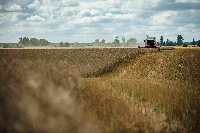Author: Jānis Kažotnieks, Latvian Rural Advisory and Training Centre
Soil is the main resource for agricultural production, has formed over thousands of years and is taught in natural science classes already from 4th grade. Soil formation is unthinkable without plants, different organisms, sunlight, heat and water. Nature has it so that all these components interact with each other and everything seems to happen by itself. However, a deeper look reveals that the processes of soil formation are logical and follow a certain order. The seed germinates only when it is in the soil, when the soil is sufficiently warm and moist, and when there is enough sunlight for the whole process. Once the sprout has sprouted, photosynthesis starts, thanks to sunlight and carbon dioxide in the air, which leads to the formation of different carbon compounds - sugars. Interestingly, about 1/3 of the sugars produced by photosynthesis are literally sucked up by the plant through the root system into the soil, where these compounds serve as food for soil micro-organisms, which in turn convert these sugars into nutrients available to plants, thus returning the nutrients produced by the plant itself back into the plant and ensuring its growth. Once the plant has grown and fruited, it slowly dies and ends up on the surface of the soil, where it is crushed by insects and then literally recycled by fungi and bacteria - just like in a compost heap. It is very important to understand that every step in this natural process is important - if any one of them falls out or becomes weak, the whole process is disrupted. Unfortunately, it must be acknowledged that, it is humans who are disrupting the normal processes of soil formation by over-tilling and using plant protection products.
Direct sowing is a form of no-till technology. In this method, the only soil treatment is the lifting of the seed into the soil. This leaves the soil virtually untouched and preserves plant residues, which in turn protect the soil from the harmful effects of the weather, limit the growth of annual weeds and provide a food base for the various organisms that live in the soil. The result is improved microbiological activity, soil structure, water and air cycle, fertility, organic matter content and disease resistance. Direct sowing reduces the amount of CO2 released from the soil and successfully accumulates the carbon in the air through the plants and micro-organisms growing in the soil, thus increasing the organic matter content of the soil in the long term. Examples from around the world show that direct sowing fields tend to produce even higher yields than conventional soil treatments. Direct sowing significantly increases productivity, but reduces labour and fuel consumption, as well as expenditure on machinery, repairs and maintenance.
A follow-up article will be available in a handbook on climate-friendly agricultural practices.
